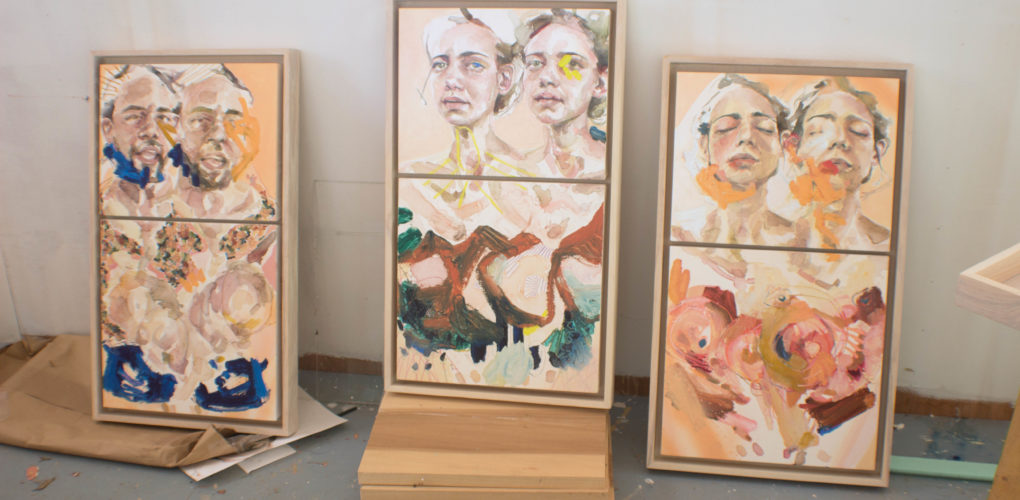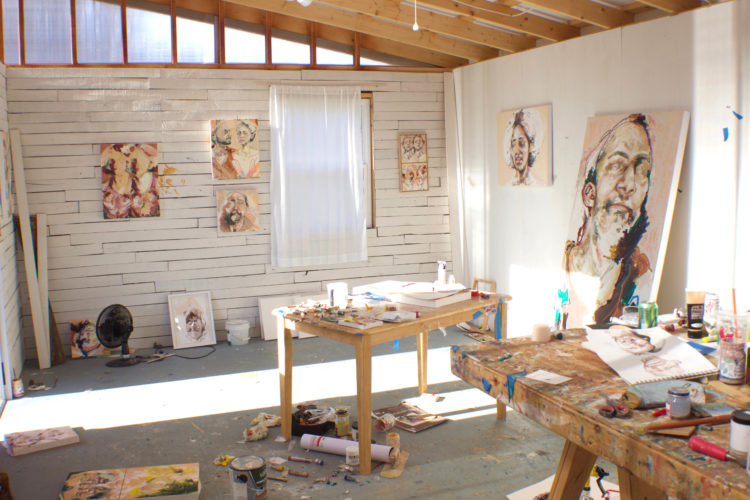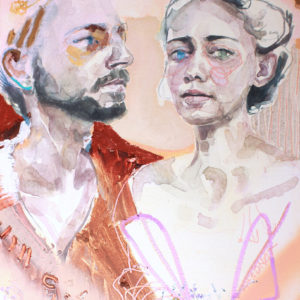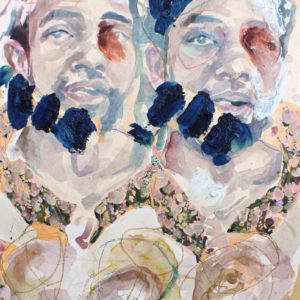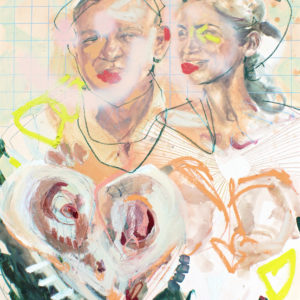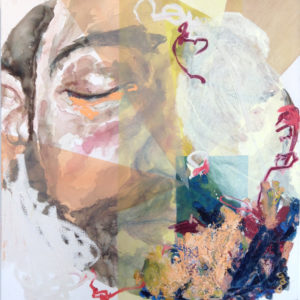The Others
 Meet the Others: Melanie Norris
Meet the Others: Melanie Norris
Q&A with the Artist
1. What are the major themes you pursue in your work?
The broad theme for my work is humanity. How we are and why we are. I paint faces in watercolor that are caught in a spiritual moment and hope to transcend the physical plane. I then, specifically in my new series, paint oil bodies below that tug back toward the fleshy rawness of the world. It’s about duality, balance. My paintings are a translation of what I see and feel in myself and others in daily life. I perhaps overthink and over feel, so my paintings are challenging to complete, and contain internal puzzles that don’t feel right until I add a certain color or line that brings forth the element of beauty to tie it all back together. I explore pain, humor, anger, wonder, but I always try to bring it back to beauty.
2. How did you first get interested in your medium, and what draws you to it specifically?
I work with watercolor and oil. I started with watercolor over 10 years ago, drawn by the challenges of its willful nature. I found a language and process that was unique – it allowed me to layer emotion and felt naturally spiritual. I wanted to push my portraits further, plumb them psychologically and add a visceral quality, so in comes the oil bar. I can layer a gutsy texture that contrasts the watercolor beautifully. And I like that I can draw with them. Doing a bold, loose drawing – with the oil bar in my fist – over a nice watercolor portrait feels rude and wonderfully real like I’m scratching into their psyche.
3. How has your style and practice changed over the years?
I feel that my style has evolved naturally and is ever-changing even if just incrementally. My practice has changed quite a bit in the last year. For 4 years, I worked out of an open studio in the River Arts District of Asheville, North Carolina. It was a cooperative studio/gallery and was a great way to learn how to talk about and sell my work. However, I began to want more privacy and invested in building a studio on my property 20 minutes outside of town. Building a workspace has been its own art project with creative and practical challenges, but so enjoyable! The trials and triumphs of this experience have catalyzed my current series, “American Dream, with Fangs.”
4. Can you walk us through your process? Do you begin with a sketch, or do you just jump in? How long do you spend on one work? How do you know when it is finished?
I work from photographs of people taken during (usually) a single conversation. I start small, sketching their portrait and then filling in with quick watercolor strokes. This establishes a connection with the face and a comfort with drawing it. I then often jump to a much larger space, 48”x48”, working quickly and loosely, with the panel flat on the ground. I like this approach because the act of painting becomes an experience of movement at that point. I prowl around the canvas, considering it from all sides, searching for more of an abstract approach using a few key features as my anchors in the portrait. After the many layers of watercolor on the face have dried, I begin drawing with oil bar and filling in color and shape. This is where I create the visual puzzle that then needs to be solved. I usually paint myself into a corner, and once I can look at it without getting frustrated, I know it’s done, or nearly so. Larger paintings take a few weeks; there’s a lot of sittin’ and thinkin’ involved.
https://www.instagram.com/p/B3nb9oBBEMH/?hl=en
5. Who are your favorite writers?
I often do a series of paintings based on a book or writer’s voice that has pricked my conscience or tapped me creatively. Milan Kundera has been a significant influence, specifically Immortality. Oliver Sacks’ book Hallucinations sparked a large series that investigates how to brain can hijack itself. I also like artist biographies; anything by Martin Gayford. Richard Meryman’s A Secret Life, biography of Andrew Wyeth is the book that made me want to make my living by painting. Until then, painting as a career was unfathomable; I couldn’t visualize how it would be possible without feeling like an imposter. Well, I guess I still feel like an imposter sometimes, but it’s a great book. Keeping an Eye Open by Julian Barnes, too. Annie Proulx short stories have a starkness about their characters that makes me want to paint people that feel simple, common, and impossibly meaningful. I could go on and on, I love reading.
6. Do you prefer to work with music or in silence?
I like music and podcasts, but when I’m working early enough in the morning that the light in the studio feels like heaven, I do like silence. When I’m working on a tight deadline, I sometimes listen to murder podcasts so I get scared and don’t want to leave the studio. It keeps me on task longer because I otherwise have a tendency to wander. That method can work too well, though, and I have to get my husband to come down from the house to walk me up.
Shop artwork by Melanie and other trailblazing artists at The Other Art Fair’s Online Studios.
Introducing The Other Art Fair Online Studios, a new online platform offering art lovers around the world access to over 800 Fair artists. The Online Studios will keep our community feeling inspired, engaged, and continue to spread joy through art.
